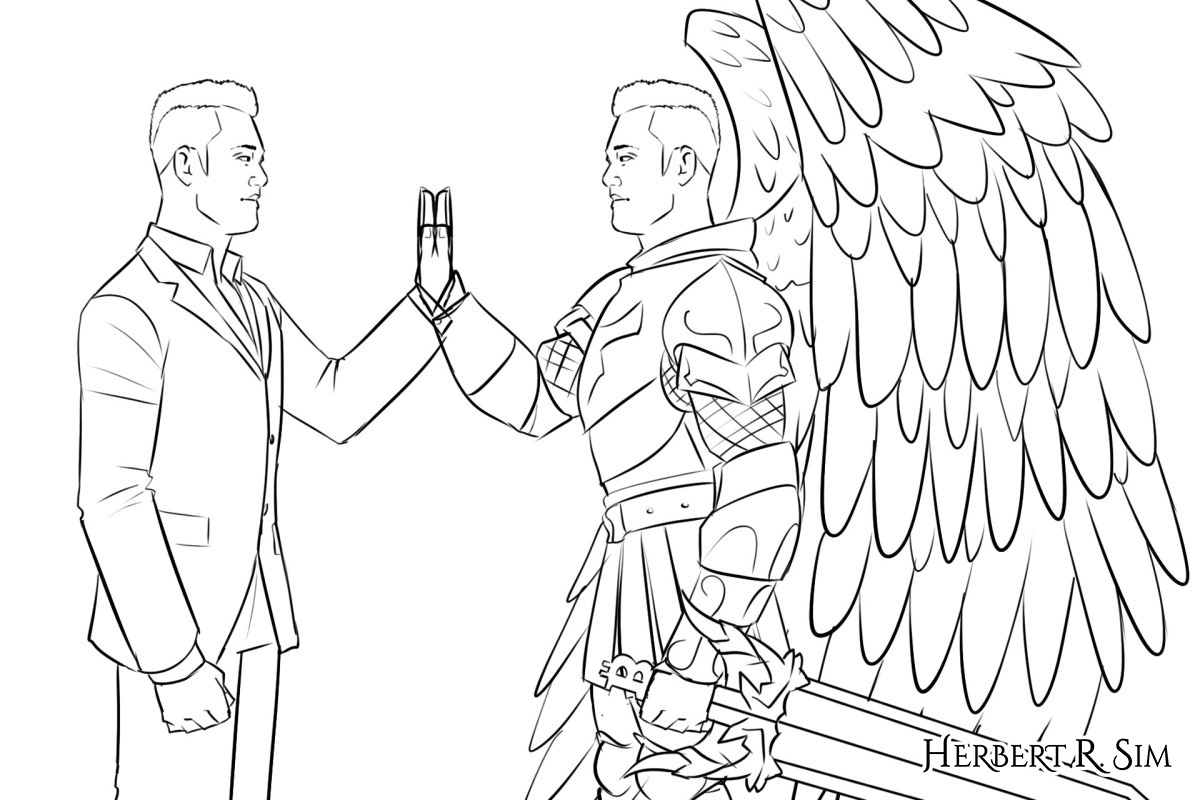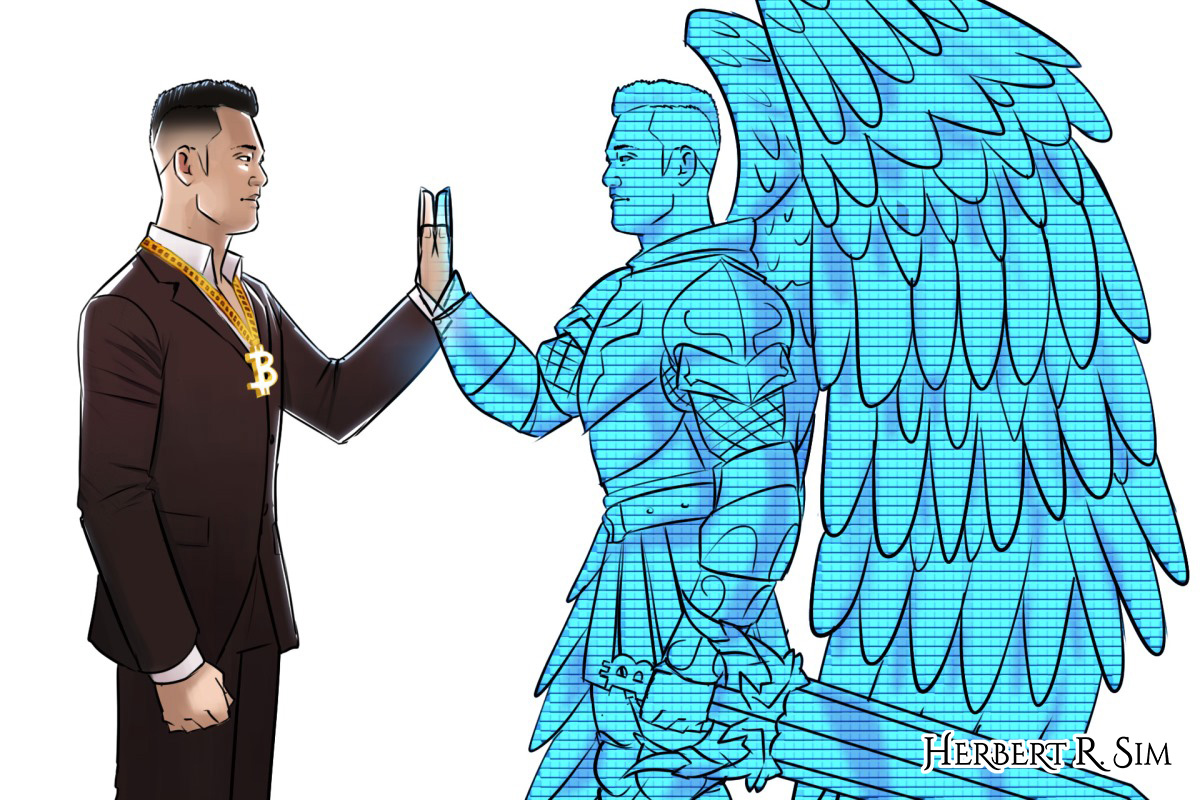
In my illustration, I sketched ‘The Bitcoin Man’ and his doppelgänger in a different dimension, in the digital world.
———————————————————
The pursuit of immortality through the transfer of consciousness into a digital realm has enamoured countless individuals. Renowned futurist Ray Kurzweil has coined this concept as “digital necromancy,” alluding to its profound implications. Drawing inspiration from popular TV series like Upload and Black Mirror, scientists and researchers are stepping into the realm of mind uploading, examining the countless facets of digital immortality portrayed within them.
The essence of uploading memories
Mind uploading, also known as “digital immortality,” envisions a process where the memories, thoughts, and consciousness of an individual can be transferred to a digital format. This concept has gained attention due to its potential to extend human life beyond biological limitations. It poses intriguing questions about identity, existence, and the nature of consciousness.
Proponents of mind uploading argue for its feasibility by suggesting that consciousness could be transferred into a computer or other physical substrates. To achieve this, there is a need to meticulously map the intricate neuronal connections of the brain and to construct a digital replica of an individual’s mind. In essence, this advancement would enable individuals to persist in the digital realm even beyond the demise of their biological bodies.
Mind uploading presents intriguing possibilities. One potential application is the transfer of memories into a new body or robot through a neurochip, allowing individuals to continue their lives in different forms. This idea has drawn inspiration from science fiction, with popular TV series like Upload depicting a future where individuals can upload their consciousness to a virtual afterlife. The show explores the challenges and ethical dilemmas associated with this technology, including questions about personal identity, privacy, and the nature of existence in a digital realm.
Furthermore, advances in AI have raised the prospect of mimicking the voices and personalities of deceased loved ones. The TV series Black Mirror echoes this particular yearning, portraying in one of the episodes, a digital afterlife where consciousness can be transferred. Such portrayals prompt us to consider the emotional and psychological implications of engaging with digital replicas of our deceased family members. It, too, raises ethical questions about the potential exploitation of people’s emotions and the blurring of boundaries between the living and the digital deceased.
As with any scientific endeavour or conceptualisation, research is paramount to provide depth and scope. Due to the possible implications for extending human life, the study of transferring memories has received its fair share of fanfare. Early investigations, however, focused on understanding the intricate neuronal connections of the brain and developing methods to create accurate digital replicas of the mind.
These studies also delved into the philosophical and theoretical aspects of the concept. Researchers contemplated questions surrounding identity, existence, and the nature of consciousness in the context of digital immortality. By examining the ethical dilemmas and implications of mind uploading, researchers sought to address concerns about personal identity continuity, privacy, and the blurring of boundaries between the living and the digital deceased.
For the scientific community, the potential role of AI in the digital afterlife is intriguing, for example, replicating the voices and personalities of deceased individuals. One notable example was the collaborative project called “Finding Jack,” which involved augmented reality company Worldwide XR and production company Magic City Films.
Both entities aimed to bring the late actor James Dean back to the screen using digital technology, akin to a posthumous digital version of James Dean, and enabling the actor to appear in the film as a secondary lead character. The goal was to utilise cutting-edge CGI (computer-generated imagery) and visual effects techniques to recreate a realistic and convincing digital representation of the iconic actor.
However, the project received significant backlash from the public and industry professionals, prompting debates on the ethics of resurrecting deceased actors digitally. Ultimately, the digital recreation of James Dean did not materialise, as was the project which was eventually cancelled due to the controversy.
———————————————————

The different dimension, digital world, or some might call metaverse; will start off as a immersive virtual world, and merging into reality in the future. To show the side of the virtual world, I added the gaming elements – Angel’s wings, medieval armor, and the legendary Blade of Bitcoin.
———————————————————
The rise of the neurochip
Elsewhere, the creation of the neurochip – a device designed to interface with the nervous system – has revolutionised the field of memory preservation and transfer. In fact, neurochips can offer unparalleled accuracy in recording and reproducing memories. This is unlike humans, who are susceptible to memory loss, distortion, and inaccuracies.
Through a complex interplay of advanced neural mapping, data storage, and computational algorithms, the neurochip can replicate intricate neural connections that may be tied to our experiences. The accuracy of this replication holds great promise in preserving the essence of our personal narratives.
A notable study had in fact showcased the advancements made and underscored the potential capability of the neurochip. In the study, researchers focused on developing an autonomous neurochip system that can record and stimulate neural activity in monkeys, as they freely behaved.
The Neurochip-2, as it was called, leveraged cutting-edge technology, including high-density electrode arrays and integrated circuits, to precisely record neural signals from multiple regions of the brain. By harnessing the power of these neurochips, researchers were able to obtain invaluable insights into the neural processes underlying various behaviours and cognitive functions.
Another example is the development of chatbots that can also emulate the personalities and conversational patterns of specific individuals. Companies like Replika and Eternime have explored the concept of creating chatbots based on the characteristics and memories of deceased loved ones.
These chatbots can tap natural language processing and machine learning techniques to mimic speech patterns and behavioral traits – reflecting the immense potential for AI to imitate the voices and personalities of the departed.
Moreover, advancements in voice synthesis technologies have been utilised to recreate the voices of deceased individuals. Researchers have also developed algorithms capable of analysing existing audio recordings, to capture unique vocal characteristics, speech patterns, as well as intonations. Such data can then be used to synthesise new speech that closely resembles the original voice.
———————————————————

In the future, merging of both the reality and virtual reality will literally come to reality, pun-intended, where the virtual reality can be felt physically in reality.
———————————————————
Navigating challenges and controversies
While mind uploading presents fascinating possibilities, it also raises significant challenges and controversies. Technical hurdles, such as mapping the intricate neural connections of the human brain, might prevent successful mind uploads.
The human brain is an incredibly complex organ, and the current understanding of its functions and structures is still limited. Thus, creating an accurate digital replica of a person’s mind remains a hefty scientific and technological challenge.
Ethical concerns related to identity and privacy are also crucial considerations. Mind uploading raises questions about the continuity of personal identity. If an individual’s consciousness is transferred to a digital format, is the resulting entity truly the same person or a mere copy? The notion of personal identity, which is deeply tied to our physical existence and the continuity of our experiences, becomes increasingly complex in the context of mind uploading.
Privacy, too, remains a key concern. In a digital realm, where consciousness can potentially be copied or accessed by others, ensuring the security and privacy of one’s digital self becomes a crucial issue. The potential for exploitation of digital copies, too, raises ethical dilemmas and requires robust safeguards and regulations.
While mind uploading remains speculative, it does invite us to contemplate our evolving relationship with technology, and the potential for extending our existence beyond the confines of our biological bodies.
The pursuit of successful mind uploading will present sticky challenges, encompassing both technical and ethical dimensions. However, within these obstacles lie opportunities for newfound discoveries.
Through continued research, scientific advancement, and meticulous consideration of ethical implications, there is a chance for mankind to delve deeper into the concept. As our understanding of human brain complexities and the evolution of AI progresses, more will be enticed by the numerous possibilities and avenues for a thriving digital afterlife.
situs toto
situs toto
jacktoto
slot toto slot
https://www.slot.pn-kuningan.go.id/
link slot
toto slot
result hk
toto togel
